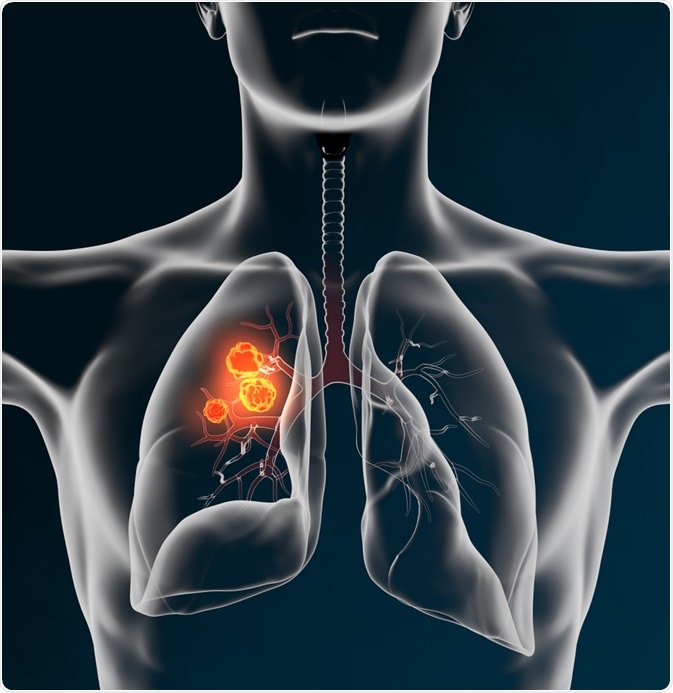However it still remains unclear whether these genes are also involved in the regulation of metastatic potential in lung cancer cells. However the detection of various RBM5 isoforms may also be used to the determine association between lung cancer histological subtype and tobacco use or even RBM5 mutation status.
In this review we summarized the diverse mechanism of TRIM proteins responsible for the most common malignancy lung cancer.

Protein responsible for lung cancer. 11042012 Lung cancer remains the most common cause of cancer-related mortality. 01032021 In lung cancer TRIM proteins employ these post-translational modifications affecting the stability of tumor-promoting and tumor-suppressive proteins for the management of tumor occurrence and progression. 10122018 Thus far the published data indicate that RBM5 is a lung cancer regulatory protein.
21092007 Blood Protein Detects Lung Cancer Even At Earliest Stage. We investigated the association of circulating high-sensitivity C-reactive protein CRP an inflammation biomarker and CRP single nucleotide polymorphisms SNPs with prospective lung cancer risk. In future S100 protein family might be applied as therapeutic targets in clinical treatment of lung cancer.
The research team found that nicotine can stimulate the protein beta-arrestin-1 which in turn promotes the production of specific proteins by cancer cells that have increased motility and invasion power resulting in the spread of metastatic lung cancer cells. The SOX family proteins are proved to play a crucial role in the development of the lymphatic ducts and the cardiovascular system. 03022015 In fact the majority of lung cancer deaths are associated with the dissemination of cancer to other organs.
Biopharmaceutical researchers have found a protein. 19042021 Using preclinical models of lung cancer driven by p53 GOF mutations Deb and his research team discovered that PLK3 activates an amino acid called serine 20 S20 a cellular building block they. Lung cancer is the leading cause of cancer-related death worldwide.
The occurrence of ubiquitylation events induced by TRIM proteins sustains internal balance between tumor suppressive and tumor promoting genes. One important reason for the poor outcome of patients with lung cancer is that the disease is commonly. American Association for Cancer Research.
14082012 Protein mutations of the RASRAFMEKMAP kinase signaling pathway were studied in the first of its kind large-scale system. The encoded protein is found in the inner mitochondrial membrane. The cancer tissue page shows antibody staining of the protein in 20 different cancers.
Chronic inflammation could play a role in lung carcinogenesis underscoring the potential for lung cancer prevention and screening. Expression of PDGFRA CD140a GAS9 PDGFR2 in cancer tissue. 12 The study showed that serinekinase BRAF was frequently mutated in human cancer at a frequency of 66 in malignant melanoma and at a less dramatic rate in other types of cancer including lung cancer 2 in primary.
16022020 In lung cancer cells the protein primarily regulates WNT signaling pathways which are active in tumor cells and passive in healthy cells. Therefore further analyses are required to determine whether other TRIM family proteins are involved in lung cancer. We applied a highly multiplexed proteomic technology SOMAscan to compare protein expression signatures of non small-cell lung cancer NSCLC tissues with healthy adjacent and distant tissues from surgical resections.
Smoking is accepted as the major risk factor responsible for 70-90 of all cancer cases although the etiology of lung cancer appears multifactorial with both environmental and genetic factors playing a role. Another SOX family protein the SOX30 transcription factor is responsible for the development. A survival analysis in the different subtypes showed a significant association only in LUAD.
Up to now about a third of TRIM family proteins which play a crucial role in lung cancer have been identified to date. Thus S100 proteins may serve as effective biomarkers for suspected or already diagnosed lung cancer patients. In this first report of SOMAscan applied to tissues we highlight 36 proteins.
The protein encoded by MPC1 is part of a MPC1MPC2 heterodimer that is responsible for transporting pyruvate into mitochondria. Moreover an increased expression level of the SOX18 protein has been found in many malignances such as melanoma stomach pancreatic breast and lung cancers. Of the 48 protein peaks that were differentially expressed between lung cancer patients and healthy individuals a subset of four peaks MZ 1205 4673 1429 and 4279 was variably expressed among patients with lung cancers of different histological subtypes SCC vs AC vs SCLC.
The University of California scientists claim that they have identified a protein that enhances the spread of lung cancer by stimulating the activity of inflammatory cells. In lung cancer both the p16INK4ARB and p53 genes are frequently inactivated and are critical determinants for the regulation of cell growth and apoptosis.

Oxidative Stress In Lung Cancer Sciencedirect

Braf In Non Small Cell Lung Cancer Nsclc Pickaxing Another Brick In The Wall Cancer Treatment Reviews
/non-small-cell-lung-cancer-causes-4588912_final-2e59864820724b15b184c2bebed13f32.png)
Non Small Cell Lung Cancer Causes And Risk Factors

Nsclc By Histology And Mutations Nsclc Non Small Cell Lung Cancer Download Scientific Diagram

At The Forefront Of Lung Cancer Treatment

Lung Cancer Radiotherapy And Chemotherapy
:max_bytes(150000):strip_icc()/carcinoid-lung-tumors-overview-4175121_color1-5c269e94c9e77c0001583dfc.png)
Neuroendocrine Lung Tumors Overview And More

Cutting Edge Medical Treatment For Advanced Non Small Cell Lung Cancer



0 comments:
Post a Comment